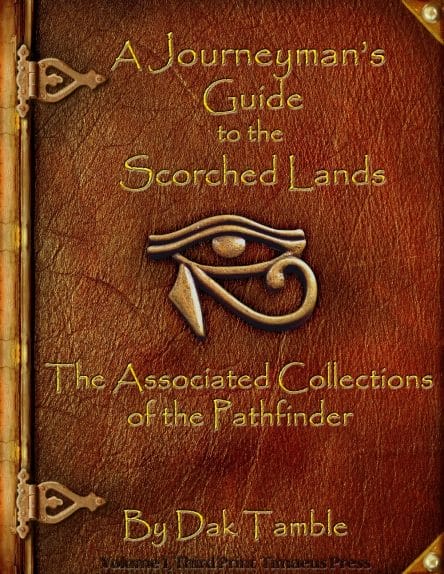[toc]
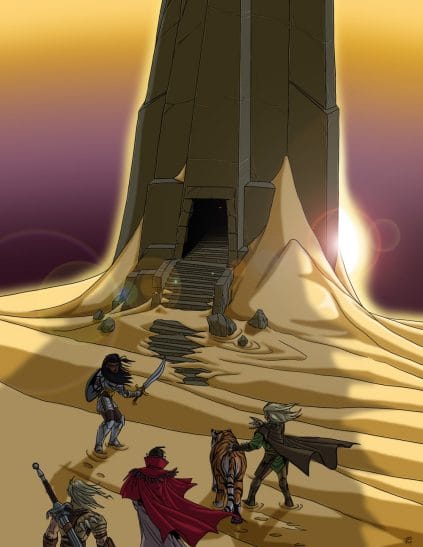
The Scorched Lands
Most of what existed in this disparate region before the Shard of the Sun hung across the sky has been reduced to burning ruins and though many societies and civilizations flourished within the borders of what is now the Scorched Lands, all have been lost to even the oldest memories. These remnants of civilizations add to the uniqueness of the wasteland, creating a rich and layered reminder of entropy on the face of Aventyr.
History
Ages ago the events that created the wasteland known as the Scorched Lands were set in motion by a group of powerful mages from Timaeus—the Obelisk Order. This penultimate group of spellcasters dared tempt the natural order of Aventyr and sought to control the power of the Sun, and the resulting catastrophe threatened to destroy the entire planet. The Obelisk mages had created a Shard of the Sun, infused with the essence of the great celestial body itself (a source of unimaginable and unlimited energy) but they were ill prepared to handle the power of a star and quickly realized their doom. The Shard that had been placed high above the planet began its plummet towards the surface and only by coming together was the Order able to avert disaster and repel the Shard of the Sun (but not before betrayal by one of their own). Unable to completely destroy their creation, they instead halted its decent and placed it in orbit around the planet. To this day the Obelisk Order performs a fell ritual each year to keep it at bay and soaring across the sky, though every rebuff costs each of them a piece of their humanity (and many question how long the mages will sacrifice themselves).
Mek’Madius, the betrayer, attempted to assume the power of the Shard for himself. He turned on his brothers during their first critical ritual and almost succeeded in damning all of Aventyr, but the power of the sun proved too much for him to handle and his skin—some say his very soul—was burned off in the resulting backlash. The last sight the Obelisk Order had of him, Mek’Madius was a scorched husk fleeing into the desolation, thought to be a broken thing and a shadow of what he once was.
In the centuries that followed what was left of the Obelisk Order built up a regimented, ordered society in Timaeus, far from the desolation they left behind in the Scorched Lands. Meanwhile, the Shard of the Sun decimated swaths of previously populated lands; hundreds of thousands perished across the region and entire civilizations fell. The mages had little choice in the location for the penultimate ritual to repel the Shard—the center of the continent was once a thriving land, rich in leyline power, people, and city states. As the great anomaly passes overhead daily, it enters the atmosphere above the Scorched Lands and releases its awesome power, burning and destroying the region, focused so strongly in this region that the Transgression incinerates nearly all it touches. As this is a daily occurrence, the power of the spell the Obelisk Order used to repel the Shard back into orbit wanes and each year it must be renewed immediately after The Shedding, when the mage-made artifact is at its weakest after releasing its full amount of energy in a burst many times more powerful than a normal Transgresion. Should they fail for any reason, the Shard of the Sun will plummet towards the surface and wreak untold havoc on Aventyr.
Yet there was one who did not want the Order to succeed: Mek’Madius. By transferring his essence to the Shard of the Sun he became the Sun Lich, and for every soul the Shard burned into oblivion, his power grew. It was not long before he created hordes of undead from the corpses of the wastes, and in campaign after campaign, he exerted his wrath against the Timaens. While they have so far been able to suppress the undead armies, the Scorched Lands have remained quiet for nearly 500 years and many in the Obelisk Order fear that unstoppable incursion brews in the sands. The Sun Lich’s stronghold is located in the inhospitable Deadlands north of Timaeus, but rumors persist that Mek’Madius possesses a vast network of structures and strongholds throughout the Scorched Lands, their purpose a mystery to all.
Modern history—where it can even be recorded—is dominated by feudal warlords that have eked out territory within the wastes, the Formian “Under Queen” and her expansionist Council of the Hive, and the treasure-hungry Gnomish Kilknogger Compendium that aims to control the untapped riches of the wasteland (by any means available).
Naming
Naming conventions within the civilized settlements are as varied as the denizens of this land. Most human names are shortened variations on traditional names of the culture, or descriptors of services they provide. Many others go by single word monikers or have given themselves self-proclaimed titles, while few still have earned monickers by the virtue (or infamy) of their deeds and accomplishments.
Male Names: Baker, Dano, Edd, Mills, Thom, Wells
Female Names: Beck, Cooki, Em, Kara, Sandra, Verna
Surnames/Monikers: Devastator, Halfsteady Rory, The Sand Flea, Sun Prince, Waster
Government
There is no controlling government in the Scorched Lands, and people are hard-pressed just to eke out a meager existence under the harsh desert sun. Most find it advantageous to come together and form groups of survivalists that can effectively control a small town, a small area, or even larger territories in the Scorched Lands.
The Warlords
Throughout the Scorched Lands people of all types have endured; these extremely hardy folk find many reasons to tough out life in such a hostile land, from treasure hunting, sun magic farming, or simply the freedom and liberties the land naturally offers. While every man and woman in the Scorched Lands is beholden only to themselves for survival, there are those that seek to subjugate their fellows for personal gains—it is not uncommon for free towns to sprout up near valuable resources, and just as likely for a local bandit to assume the title of warlord and feudalize such encampments.
 Regardless of their origin, warlords are often dangerous and respected for their martial or arcane prowess as one cannot assume the title without the support of a band of loyal followers (though if they are loyal through respect or fear is another matter entirely). Many times their methods are the same—they aim to collect taxes and tithes from the working populace in exchange for territorial protection. Unfortunately, most tax their populations into situations of extreme poverty on purpose as to deny them the ability to mount an insurrection. Upon entering an encampment one can immediately surmise the nature of the town; if eyes dart to the ground and people flutter into shelters and avoid contact, it is probable that you have entered a warlord’s territory. Many times a local band will run a settlement in the absence of their warlord, and these lieutenants and sergeants are usually cruel and despicable of creatures (human or otherwise).
Regardless of their origin, warlords are often dangerous and respected for their martial or arcane prowess as one cannot assume the title without the support of a band of loyal followers (though if they are loyal through respect or fear is another matter entirely). Many times their methods are the same—they aim to collect taxes and tithes from the working populace in exchange for territorial protection. Unfortunately, most tax their populations into situations of extreme poverty on purpose as to deny them the ability to mount an insurrection. Upon entering an encampment one can immediately surmise the nature of the town; if eyes dart to the ground and people flutter into shelters and avoid contact, it is probable that you have entered a warlord’s territory. Many times a local band will run a settlement in the absence of their warlord, and these lieutenants and sergeants are usually cruel and despicable of creatures (human or otherwise).
While warlords tend to be cruel and maniacal, they are not above barter and reason. Many parley to find out what can be offered (if not taken by force) though caution is recommended when dealing with any warlord, as even the most charming leaders would not hesitate to strike a deal followed by a wicked and sudden betrayal. It is of no surprise that the warlords of the sands are in constant conflict with each other over resources and territory; incursions and clan wars are commonplace, deadly to both feudalistic regimes and the local populace. All of them unite in one respect, however: despising the Gnomish Kilknogger Compendium, viewing them as foreign invaders. Mutants are a touchy subject between individual warlords and while some accept them with open arms, others kill survivors of the Shard on sight. All warlords, and for that matter everyone in the Scorched Lands, fears the formians and their Underqueen.
Formian Queen
The last remaining formian matriarch on Aventyr, the Underqueen assumed the title by subjugating all other royal peers on the planet (a meticulous process that took eons to accomplish). Having come to the Scorched Lands before the burning to dominate her kin in the area, she launched a long-running and massive campaign against them resulting in the Formic Wars—an epic struggle lost to the legends and lore of the present age. As the sole queen, she is responsible for all formian behavior. While typically content in her dominance of the formians of Aventyr, the Underqueen’s ambition and patience border on true evil and rival the cunning of a high demon lord; her current goals are numerous and vast in scope, and some of them involve the surface world.
 No one knows the true location of the main hive (which some say extends throughout Aventyr and even beyond) but nest exits can be spotted in the Scorched Lands by their tower like protrusions from the sands. These spires of mounded dirt and grit extend into the sky at least dozens of feet and sometimes scores (with certain structures said to soar over a hundred feet into the sky). From these spires formian workers and warriors often attack settlements in search of slaves, food, or silver. No one knows what the formians want with such vast quantities of argent metal, but it is often stated that even a few pieces of silver can save your life from one of the brutal insects.
No one knows the true location of the main hive (which some say extends throughout Aventyr and even beyond) but nest exits can be spotted in the Scorched Lands by their tower like protrusions from the sands. These spires of mounded dirt and grit extend into the sky at least dozens of feet and sometimes scores (with certain structures said to soar over a hundred feet into the sky). From these spires formian workers and warriors often attack settlements in search of slaves, food, or silver. No one knows what the formians want with such vast quantities of argent metal, but it is often stated that even a few pieces of silver can save your life from one of the brutal insects.
While formic invasions on a large scale are extremely rare, the people of the Scorched Lands always retain the primal fear of insect hordes marching across the badlands. The machinations of the Underqueen are not for mortals to question, however, and those that have are seldom seen from again.
Council of the Hive
The Council of the Hive is a collection of formian myrmarchs that act as the direct administrative force for the Underqueen; though she can command each of her subjects individually or all of them collectively, it is often more efficient to outsource her commands to loyal, direct subordinates to carry out the minutia of details and day to day tasks. These formians are the rarest of exceptions within the hive castes. They are individuals in every sense, with their own thoughts and ambitions, and though beholden to the Underqueen their loyalty to her is never entirely assured. While this may seem like an imbalance in an otherwise orderly system, the necessity to alleviate the psychic load from her highness supersedes their innate compulsion for conformity. Thus the myrmarchs make up an elite, noble caste of hive society and act as high ranking officials in domestic and military matters.
 Cult of the Hive
Cult of the Hive
A group of humanoids that worship the Underqueen as a living god. the Cult of the Hive (or Indoctrinated as they call themselves) are always accompanied by a dominated formian slave under the direct control of a formian taskmaster. While the taskmaster does not need to be present, this special connection is rumored to extend directly to the Underqueen’s will. Anyone can join the ranks by passing an indoctrination ritual—those who succeed in the taskmaster’s eyes are promoted to fully dominated slaves. The highest-ranking officials in the Cult of the Hive’s hierarchy are slaves passed directly to myrmarchs and given free will.
The Cult of the Hive acts primarily as an infiltration and information gathering unit for the formians, but they are also tasked with carrying out more indiscreet actions for which the Underqueen does not wish her formians directly involved. The group uses a symbol to designate private areas, sometimes left as a calling card—a six-pointed radial inside a circle representing the legs of an ant surrounded by the all-encompassing, all-seeing queen.
Gnomish Kilknogger Compendium
The GKC is part trading-company, part mercenary-group, but wholly corrupt. Barter is the language of their trade with an emphasis on cold, hard, gold. Known everywhere as the Water Barons, the GKC was established centuries ago by Klaxon Kilknogger as an enterprising expedition into the Scorched Lands in order to harvest the powers of Sun Magic directly. In the early days of the Compendium research and development trumped all other concerns, and their discoveries led to a rise in survivability and quality of life in the Scorched Lands. The GKC was the first to develop sun oil (and subsequently, the cool suits), and they cultivated the waternut trees and firegrass into an agricultural boon. Well-respected pioneers in the region, the countless other inventions they’ve developed (both great and small) have been an undeniable boon to the peoples of the sands (despite whatever ill will may be harbored against them today).
Whatever respite from the harshness of life in the wasteland the GKR initially offered, much of it faded away when Klaxon Kilknogger died in a terrible accident and the family-run business destroyed itself from the inside. Eventually, Nitpik Kilknogger assumed control through force and his great-grandson, Filk Nitpik Kilnogger III, runs the Compendium to this day—for all his shortcomings, Filk possesses a business mind unmatched in all of Aventyr.
Their main source of income for the last two centuries has been the water refinery on the southern shore of the Grave Morass. The GKC has developed technology able to affordably transform the crude sludge of the Morass into clean, drinkable water using the power of Sun Magic, which they then sell to badland settlements. Anyone trying to farm waternuts is harassed, and entire orchards are cut down in retribution for even planting more than what a farmer has negotiated to sow. Towns are visited regularly by GKC tax sheriffs, usually escorted by chained and bound fire elementals—unsurprisingly, they always get paid and rarely hesitate to extort someone for more than their due. Until recently these tariffs have been manageable, but lately, the merchants have been taxing more and more while rationing less and less water.
Mutants
The western portion of the Scorched Lands consists of a massive series of canyons, mesas, and plateaus collectively called the Fissures. This confusing landscape is perfectly suited to the reclusive lifestyle led by the many mutant clans who inhabit this area.
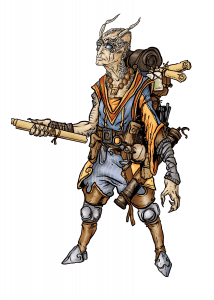 Most mutants are (or at least were) humans at one point but it is not uncommon to see evidence of the other races—their mutations are often aesthetic only, with very few having any positive benefit from their transformation. Their changes are as varied and diverse as one can imagine, ranging from saggy skin to multiple eyes, and other physical deformities.
Most mutants are (or at least were) humans at one point but it is not uncommon to see evidence of the other races—their mutations are often aesthetic only, with very few having any positive benefit from their transformation. Their changes are as varied and diverse as one can imagine, ranging from saggy skin to multiple eyes, and other physical deformities.
The power of the Shard of the Sun can often mutate a normal individual instead of destroying them. Sometimes even a glancing bit of energy from its passing, over time, creates minor mutations (see the Table SL-2: Transgression Mutations for possible mutations). In Timaeus magical experimentation has led to the creation of mutant slave trade; many of these individuals are more intelligent and escape to freedom in the Fissures to rally others behind their causes. Some escapees have set up an elaborate and complicated system of ferrying their brethren from bondage, a nuisance that many in Nyamo have complained of for decades (though when they might respond is anyone’s guess).
Culture
The collective peoples of the Scorched Lands call themselves Pilgrims, and it is customary to greet folk with this term as a sign of respect and kinship (though other groups identify with whatever term best describes them: wastewalkers, mutants, nomad, and the like.) It takes a hard soul to warrant a life in what many in Aventyr call the worst place in the world, and these rugged individuals pride themselves on it. Life here is governed by a strict sense of survival and mutual respect—most settlements have rudimentary laws that keep the peace amongst the collective people while letting personal and property disputes be handled amongst the parties invested.
Few people journey into the Scorched Lands let alone travel out and as a consequence, the Common tongue has become antiquated, formed into a mix of formality and turns of phrase unique to the area. This can be a complication of nuance in a land where a wrong look could turn deadly, making speaking a game of sizing up a potential friend or foe as well as a matter of wit. It is fully customary to refer to individuals with the appropriate prefix (such as Mister, Misses, or Miss) unless on a first name basis, though sometimes then as well.
Cities & Settlements
Ravine
Built into the crust of Aventyr in the central portion of the Scorched Lands is the city of Ravine, the largest settlement of the region. Hovels and dwellings crowd the sides of the busy canyon walls, while the surface level is left almost completely barren save for the sheltered guard posts and canyon lifts.. At the lowest level a stream of fresh, cool water runs throughout the canyon floor, created from a natural aquifer deep underground that runs south and west into the fissures. Pilgrims of all sorts have lived and survived here for centuries, each generation building dwellings closer and closer to the surface as space becomes more limited. The most prized and ancient of dwellings near the canyon floor are sought after and conspired for, often in the nearby market level’s giant lifts (spaced sporadically throughout to ferry goods to and from the surface on giant rock-counterweight scales). Silver plated reflectors set up along the sides of some of the canyon walls reflect sunlight into special cutout terraces that, with irrigation from the stream, provide food for the citizens.
Ravine is run by an elected mayor that serves a five-year term and all positions of power within the city are elected officials or appointed by the mayor.
Regional Unique Characteristics
Weather
As normal weather patterns pass into the Scorched Lands they quickly dissipate in the intense heat over the sands, sometimes disappearing without a trace but not always; it is not unheard of for powerful rain and thunderstorms to rip through the region whipping up dust walls, ash clouds, and even leaving pools of ashen sludge that can swallow unsuspecting travelers. In areas that receive heavier amounts of rain the ash and sand congeal to form semiliquid lakes of viscous slag called morasses.
The Transgression over very wet environments such as large bodies of water, oceans, and swamps, has effects that are somewhat unique. The rapid rise in temperature produces a large amount of steam and water vapor, and the heat currents can often cause steam spouts to form—these tornadoes of vaporized boiling water are quite dangerous and have been known to sink many a ship. In general, the Transgression over water creates a tremendous amount of airborne moisture, most of which becomes steam that creates a thick mid-level fog that helps to abate the power of the Transgression near the cost. In swampy areas, this increased moisture creates a super-dense growth zone on the immediate border of the Transgression path, and many areas downwind of a seaside zone are incredibly lush and fertile, having daily tropical rainstorms creating a perfect environment for an abundance of plant and animal life in an otherwise inhospitable region.
Geography
The Scorched Lands cover a swath of territory in the center of Aventyr and although the Shard of the Sun orbits the entire planet, only here does its power interact physically with the world. The region’s outside borders are transition zones and assume many of the features from their parent climate, but as one moves into the interior the landscape quickly transforms into a desolate wasteland devoid of most life. During the daytime hours temperatures typically range from 90° to 120° Fahrenheit (32–48° C) as in a normal desert climate, whereas at night some places can fall to as low as 40° Fahrenheit (4° C); it is rare for temperatures to rise or fall beyond these norms (and when they do, it is often because of the Transgression).
The Shard of the Sun passes overhead twice daily, once around midnight and again around noon, always 12 hours apart (on a semi sun-synchronous orbit). As the planet rotates below the Shard is always between it and the sun during noon (or midnight) local time. The Transgression, as it is formally called, takes approximately one hour from the time the Shard appears on the eastern horizon until it passes completely under the western sky. During the Transgression a bright “second sun” appears in the sky, emanating waves of heat and bright light; as the Shard reaches the apex of the noon sky temperatures rise drastically, reaching upwards of 240° Fahrenheit (115° C). Fortunately, these extreme temperatures last for only “the dead 6’s”, (66 seconds) as the Shard passes directly overhead and the surface experiences the full blast of its power. This burning heat can be endured as long as one takes shelter, or finds cover from the direct rays of the Shard; the nightly passing of the Shard has no adverse effects as it receives no power from the sun.
The landscape of the Scorched Lands is mostly desert wasteland, as any viable topsoil burned off centuries ago—dust, sand, and ash cover everything. The vegetation and plant life common to other climates are practically nonexistent, and only stone structures remain unclaimed by the scorching sands, remnants of structures that eerily outline the shapes of houses, mills, and other buildings. These corpses of civilization act as a reminder that once people did thrive here, but any life that remains has adapted to survive in this harsh environment.
Even in this desolate destruction, there is diversity, however, in variations of life that speaks to the tendency for Aventyr’s denizens to survive despite whatever assails them. The northern reaches of the Scorched Lands are dominated by the Sea of Shards, endlessly shifting sand dunes dotted with strange ashen stalagmites that rise from the dunes. The central region comprises the Grave Morass, a vast pit filled with congealed ash, sand, and oil (a geographical formation unlike anything on Aventyr). The western Scorched Lands comprise a series of giant canyons and badland formations named by locals as the Fissures; primarily inhabited by mutants, this region is virtually unexplored. To the east, bordering the sea, are the salt flats of Water’s End and it’s said that anything composed of water that enters the territory never leaves in the same form.
Dangers and Effects
While the Shard of the Sun scorches the land below and destroys most life, a strange residual effect occurs in the Scorched Lands where its touch graces Aventyr—the entire zone is affected by a permanent endure elements spell. Any creature that spends at least 10 minutes in the Scorched Lands’ borders are affected by this phenomena and it lasts until 24 hours are spent outside of the zone, minimizing any heat dangers except during the direct Transgression (dangerous temperatures only exist for 5 minutes before and after the Shard’s direct passing; no environmental checks are required outside of this time.) During this daily period of intense heat, Fortitude saves against the environment need to be made by creatures involved in strenuous activities (such as combat) in an exposed area but are otherwise unnecessary. During the direct Transgression as temperatures rise to greater than 240° F (115° C), unprotected creatures must make a Fortitude Save (DC 15 +1 per previous check) or take 10d6 points of damage (half damage on a successful save). Half of this damage is considered fire damage and the other half is untyped. The direct Transgression lasts for 66 seconds (11 rounds). Any creature slain by the Shard must make a DC 20 Will save or be affected by the Ashen Death (see Table SL-1: Ashen Death).

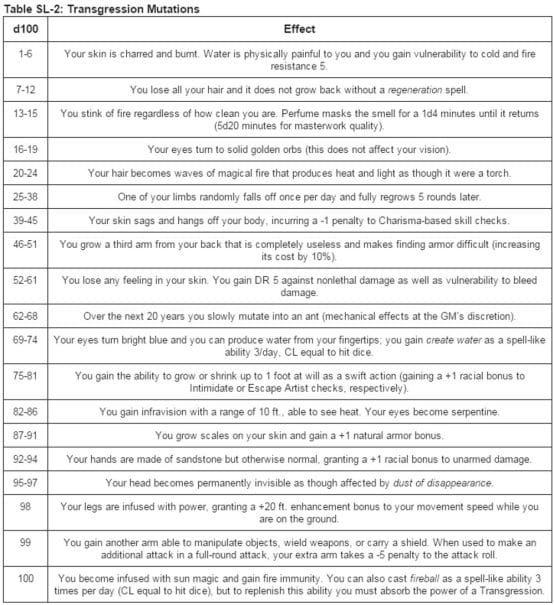
The following statistics are for Pathfinder 1st edition but can be converted into whatever system you prefer.
 Ashen Template (CR varies)
Ashen Template (CR varies)
When a creature other than an undead is destroyed by the Shard of the Sun, it has a chance to rise as an unintelligent undead zombie with the ashen template. This is a simple acquired template applied in addition to turning the creature into a zombie of the appropriate HD.
Ashen Death: Any non-undead creature slain by an ashen zombie rolls immediately on Table SL-1: Ashen Death.
Ashen Skin: All of the base creature’s skin is replaced with a thick layer of ash that cracks and breaks as the zombie moves. This makes the ashen creature slightly more robust, but also more susceptible to powerful blows. The creature gains a +1 natural armor bonus and any critical hits against it are automatically confirmed.
Ashen Miasma
Type curse, disease (contact); Save Fortitude DC 16
Onset immediate; Frequency 1/round until successful or removed from area
Effect 1d6 Con damage and fatigued; Cure ashen miasma can only be cured by successfully casting remove curse on the victim while they are fully submerged underwater
The Shedding
Roughly once each year the Timean mages of the Obelisk Order gather within a secret location in the Scorched Lands to partake in a ritual. Back in their homelands they celebrate a festival day but in reality, a dark truth lies below the joyful tidings—the magic that keeps the Shard of the Sun in orbit around the planet fades over time and only the ritual performed during the Shedding keeps the Shard from crashing into the planet, destroying all life. While it has gone uninterrupted for over a thousand years each time it is always marked by terrible death and suffering among the elite of Timaeus.
A normal Transgression lasts for 66 terrifying seconds, but a Shedding lasts for an excruciating 666 seconds and bake the surface with such an immense heat that no tool has survived measuring it (though estimates place the temperature between 600° and 800° F (315–426° C). Low-quality swords and armor have been known to melt to slag, anything made of wood instantly combusts, and unprotected objects vaporize into ash.
After a Shedding, the earth is cracked and parched dry, like the shedding scales of a world-sized snake. The first winds bring about terrible ash storms that have lasted for days. Even worse are Morasses, formed when rainstorms sweep in after a Shedding (turning all that ash to liquid stone). If there was any benefit at all to the Shedding it is that after it ends, fresh pools of sun magic can be harvested all over the Scorched Lands.
Sun Magic
 Sun magic is a remnant of The Shedding, energy so dense that it takes physical form as a glowing orange liquid hot enough to burn unprotected skin (2d6 fire damage for each round of exposure). With careful preparation, however, it can be handled safely, charged into prepared crystals which other magical devices use as power. Though it can be found in the Scorched Lands where the magic of the obelisk ritual connects with the Shard, the rain of magic continues across the ocean into the deadlands and across northern Timaeus (and even further east into the ocean).
Sun magic is a remnant of The Shedding, energy so dense that it takes physical form as a glowing orange liquid hot enough to burn unprotected skin (2d6 fire damage for each round of exposure). With careful preparation, however, it can be handled safely, charged into prepared crystals which other magical devices use as power. Though it can be found in the Scorched Lands where the magic of the obelisk ritual connects with the Shard, the rain of magic continues across the ocean into the deadlands and across northern Timaeus (and even further east into the ocean).
Flora and Fauna
Nightbloom Acacia
DC 15 Knowledge (nature)
Named for its ability to bloom at night and absorb moisture from the air, this plant is dormant for most of the day, its small flat leaves sprouting near sunset and staying open until dawn to draw in moisture. The nightbloom acacia has a thick light brown bark that grows to a thickness of many inches to protect from the Shard’s rays and blooms once a month during the full moon, the resulting flowers prized for their use in fragrances and dyes. Because of the Shedding, most trees do not exceed 8 ft. in height.
 Firebloom Cactus / Shader Tree
Firebloom Cactus / Shader Tree
DC 14 Knowledge (nature)
This brown-skinned cacti is covered in small hairs and smells reminiscent of honey. The medium-sized center trunk of a firebloom cactus blossoms out into a thick, bulbous overgrowth that extends up to 10 ft. high and with branches 5 ft. long that form an outgrowth that protects from the Shard’s rays, shading the relatively delicate trunk. Once a day during the Transgression flowers open atop the canopy and seemingly absorb the Shard’s rays before sulking back into the outgrowth. Shader trees are rare and valued for protection they obviously offer, and are often confused with the deadly corpse cactus.
 Corpse Cactus / Dead Man’s Rest
Corpse Cactus / Dead Man’s Rest
DC 20 Knowledge (nature)
This plant closely resembles its cousin, the firebloom cactus, but though it has a similar size and shape as well as brown skin, short hairs, and an odor of honey, it offers anything but safe respite. Once a creature touches the trunk and brushes up against the hairs of this desert flora, spines shoot out from inside the trunk (Atk +2, 1d2 points of piercing damage + DC 15 Fortitude save or paralyzed and 1d3 Constitution drain per round). Once injected into the victim the spines inject a paralytic poison that traps the creature in place while the tree siphons all nutrients and when its prey is unconscious or dead, the overgrowth on the tree opens and vine-like tendrils grab the body, slowly pulling it up and placing it prone on top of the corpse cactus. Here the plant sucks the victim bone dry, adding the remaining bulk to its “sun shield”.
Waternut Tree
DC 18 Knowledge (nature)
Of the little vegetation that persists in the Scorched Lands, the waternut tree is arguably the most important plant of them all. This tall (15-20 ft.) thorny, thin, leafy tree produces hanging sacks of an edible nut used heavily in wasteland cuisine. The top of the tree has giant, white leaves that canopy the trunk and fruits during a Transgression, following the Shard like a sunflower.
The sack of a waternut is more valuable than the nut itself, as approximately 2 gallons of fresh water can be found within. One tree can produce as many as 10 hanging sacks (the fruiting time is approximately 5 days) by utilizing a symbiotic relationship with fire grass, an algae always found around the plants. The waternut tree uses its white leaves to capture the rising steam from the fire grass and it cools the underside of the large leaves as it condenses, protecting the leaf but also allowing it to absorb the extra water. One waternut sack of water is capable of producing a 15 ft.-wide patch of fire grass (and therefore capable of producing at least 5 more waternuts).
Fire Grass / Fire Algae
DC 13 Knowledge (nature)
Fire grass is an algae that grows symbiotically with the waternut tree, covering the ground around the plant in a 15-ft.-radius patch that resembles a low grass or moss, but with a rust or reddish hue. Absorbing water from the waternut sacks when they fall to the ground, fire algae undergoes a process called photosynthetic replication, reproducing astonishingly fast with very little consumed energy. When the Transgression occurs, fire grass’ high water content burns off before the algae itself, releasing steam all around the waternut tree. Fortunately, fire algae is not harmful to most creatures, though it often convinces creatures and travelers unfamiliar with the Scorched Land that the water from a waternut tree is not to be trusted.
Protections Against the Shard
Many creatures have adapted to protect themselves from the harshness of the Shard’s rays, searching for ways to survive the yearly terror of the Shedding. Intelligent species were quick to adapt and many techniques for survival remain unchanged for centuries.
Finding a zone of safety from the Shard (at least a 5 ft. square of full cover) can be a matter of life or death during a Transgression and though simply staying out of the direct rays of the Shard can save your life, without protections there is still great danger from exposure. While in cover with no other protections during a Transgression (which lasts 11 rounds) a creature takes 1d6 points of nonlethal damage per round.
 Cool Suit
Cool Suit
A cool suit is any suit of clothing or armor treated in sun oil that specifically covers the entirety of the body and leaves nothing unprotected exposed. Most cool suits unfurl or unwrap to cover the body like a cape in time of need, whereas others are more intricate and tailor-made to an individual’s needs—be it extra appendages, equipment considerations, or personal tastes. Once treated in sun oil the suit protects the wearer from one full exposure of the Shard, after which the concoction flakes off and the suit is no longer protected until another coating is applied (because sun oil is costly, most folks treat a cool suit as a last resort). A cool suit offers no protection against a Shedding.
Deathbed
Honed over the centuries, one of the oldest techniques for survival in the Scorched Lands is the deathbed. It entails digging a grave-like bed in the sand, laying in it, and covering oneself with at least 6 inches of material, you must have some way of breathing through the material. As the Transgression occurs temperatures rise, but underground a creature stays mostly protected. Anyone can make a deathbed within 10-12 rounds.
Significant Characters
The Fiery Lady
The Fiery Lady is a mystery of the Scorched Lands. This woman—whether she is an elemental in human form, a high-level fire sorceress, something in between, or none of these categories—wanders the Scorched  Lands between the sea on the east and the fissures to the west in a meandering path with few interruptions.
Lands between the sea on the east and the fissures to the west in a meandering path with few interruptions.
When assaulted she does not defend herself or attack in response, but anyone who takes arms against her with a melee weapon takes 1d6 points of fire damage. When she dies, she collapses into a pile of ashes that do not disperse under any conditions, reforming 5 rounds later (after which she continues her walk as if nothing happened.
Occasionally, “worshippers” are found following the Fiery Lady, usually elementals or creatures who are adapted to the heat of the Scorched Lands. Most if not all of her “followers” need to hide once a day as the Shard of the Sun passes overhead, but the Fiery Lady stops and faces the Shard when it goes by, turning in place as it moves from east to west.
Gods
There are no gods unique to the Scorched Lands; each culture developed an understanding of the world through survival and most know that it was magic that made the land this way, not deities. Peoples and settlements tend to retain some of their original cultural identity, and shrines exist to all manners of divine beings, be they human, elf, or mutant. Religious temples in the Scorched Lands are extremely rare sights, usually devoted and built to a passing deific fad or cult and with time or warfare, the originators die off or leave behind a shell of a building much like the land itself.
A Journeyman’s Guide to the Scorched Lands
[Note that these pilgrim pages are written in a magical form of ink that only shows itself during the Transgression, its pages immune to damage from the Shard of the Sun. A method of some kind (magic, mechanical, or otherwise) must be used to view text and scribe it during those crucial 66 seconds, but this was Dak’s key discovery and one that changed not only his journey but that of the desert itself, forever.]


 Cult of the Hive
Cult of the Hive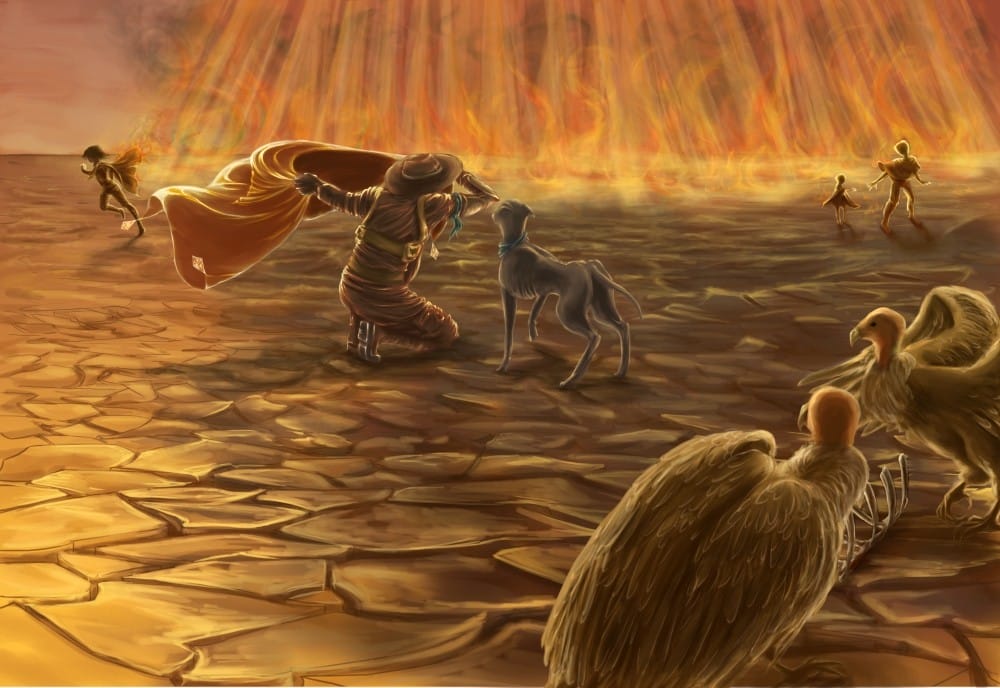 Ashen Template (CR varies)
Ashen Template (CR varies) Firebloom Cactus / Shader Tree
Firebloom Cactus / Shader Tree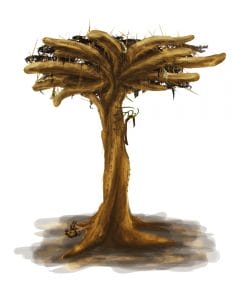 Corpse Cactus / Dead Man’s Rest
Corpse Cactus / Dead Man’s Rest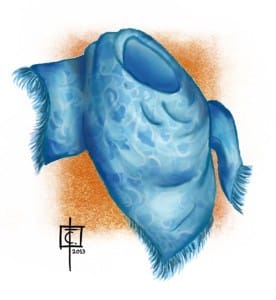 Cool Suit
Cool Suit